 |
|
|
| (Information by John De Cleene, with additional information from The Times Atlas of World History, Geoffrey Barraclough (Ed, Hammond Inc, 1979), and from External Links: Cariacou.biz, and Government of Grenada, and Grenada (Encyclopaedia Britannica), and Grenada (Rulers.org), and Granada (Zárate's Political Collections). |
|
|
| 1957 - 1962 |
James Monteith Lloyd |
UK administrator. |
| 1962 - 1964 |
Lionel Achille Pinard |
UK administrator. |
| 1964 - 1968 |
Sir Ian Turbott |
UK administrator. Knighted and made governor for 1967. |
| 1967 |
Grenada becomes an 'Associated State' with the United Kingdom, achieving internal self-government. The United Kingdom continues to control the country's foreign affairs and defence. 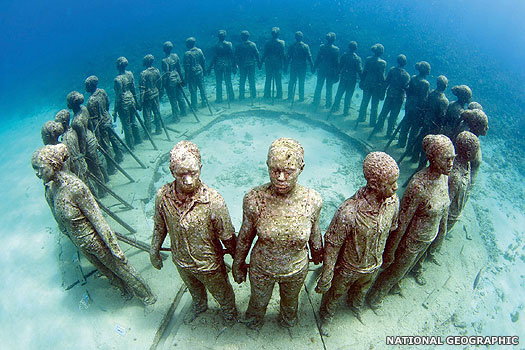 This 'Ring of Statues' in Grenada's Underwater Sculpture Park was created in 2006, following Hurricane Ivan, by British 'eco-artist' Jason de Caires Taylor, being located in the Molinere-Beauséjour Marine Reserve in Grenada This 'Ring of Statues' in Grenada's Underwater Sculpture Park was created in 2006, following Hurricane Ivan, by British 'eco-artist' Jason de Caires Taylor, being located in the Molinere-Beauséjour Marine Reserve in Grenada |
|
| Eric Gairy, a trade unionist and head of the Grenada United Labour Party (GULP) takes over the process of governing from the Grenada National Party (GNP). He will head the government, becoming the country's first prime minister in 1974, until he is overthrown in 1979. |
|
|
| 1968 - 1974 |
Dame Hilda Bynoe |
First female UK governor. |
| 1974 |
On 7 February 1974, Grenada becomes an 'Independent Constitutional Monarchy' with the monarch of the United Kingdom as the head of state, represented in Grenada by a governor-general. Independence is followed by violence, instability, and controversy, and there is disillusionment with Eric Gairy's government which has presided over economic decline. |
|
| 1974 - 1978 |
Sir Leo de Gale |
UK governor (and first governor-general in 1974). |
| 1978 - 1992 |
Sir Paul Scoon |
Governor-general, but powerless for periods. |
| 1979 |
The Marxist-leaning Maurice Bishop deposes Prime Minister Sir Eric Gairy while Gairy is out of the country. Bishop takes over as prime minister and imposes a dictatorship. He receives substantial support from communist Cuba but he does lead the country towards substantial economic improvement. 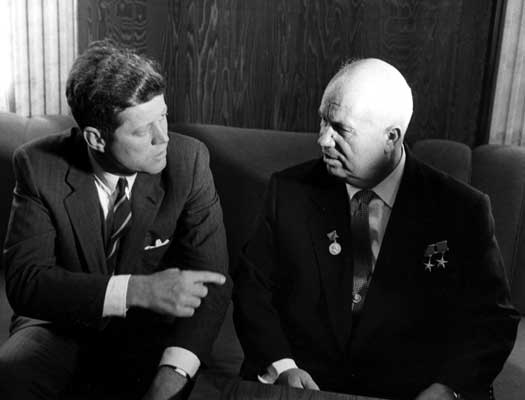 Photographed together here, John F Kennedy and Nikita Kruschev had, in 1962, played the world's biggest game of brinkmanship as the USA and Soviet Union vied for supremacy, centred around Cuba Photographed together here, John F Kennedy and Nikita Kruschev had, in 1962, played the world's biggest game of brinkmanship as the USA and Soviet Union vied for supremacy, centred around Cuba |
|
| 1979 - 1983 |
Maurice Bishop |
Dictator. Overthrown and assassinated. |
| 1983 |
The United States in particular fears the establishment of another communist government in the Caribbean. On 14 October 1983, rivals of Maurice Bishop in the communist 'New Jewel Movement' overthrow him, being led by General Hudson Austin. Bishop is assassinated on 19 October 1983. |
|
| 1983 |
Hudson Austin |
Army general. Dictator. Overthrown. |
| 1984 |
The military coup and its threat to American nationals provides the pretext which the United States needs to lead a coalition of West Indian countries in an invasion which overthrows Austin's government. Governor-General Sir Paul Scoon assumes the position of head of government until a provisional administration can be established. Democracy is restored, and the provisional administration is established in December 1984. Herbert Balise, who had led the country in the 1960s, now becomes prime minister as leader of the New National Party (NNP). Tourism, however, does not easily rebound. 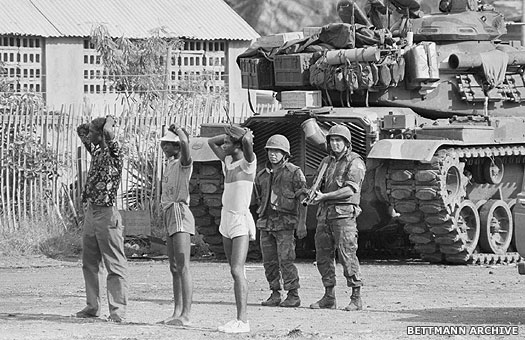 Two US soldiers hold three suspected members of the People's Revolutionary Army at gunpoint in St George's, Grenada, during the Grenada Invasion of 1984 to restore democracy to the island upon the orders of President Ronald Reagan Two US soldiers hold three suspected members of the People's Revolutionary Army at gunpoint in St George's, Grenada, during the Grenada Invasion of 1984 to restore democracy to the island upon the orders of President Ronald Reagan |
|
| 1992 - 1996 |
Sir Reginald Palmer |
Governor-general. |
| 1996 - 2008 |
Sir Daniel Williams |
Governor-general. |
| 1997 |
Prime Minister Keith Mitchell of the NNP visits Fidel Casto, president ofCuba, thereby creating controversy and drawing the fire of the Democratic Labour Party. Nevertheless, the island's economy continues to recover, and Mitchell is re-elected in 1999. |
|
| 2001 - 2003 |
The international 'Financial Action Task Force' takes aim at the Grenada government's weak approach to money laundering. Seventeen Grenadian banks are closed. They are linked to the First International Bank of Grenada, which had collapsed in 2000 with losses of $150 million to US depositors. The international community is satisfied with Grenada's anti-laundering steps and, in 2003, restores the country's standing. Still, only five offshore banks remain in operation after all the closures. 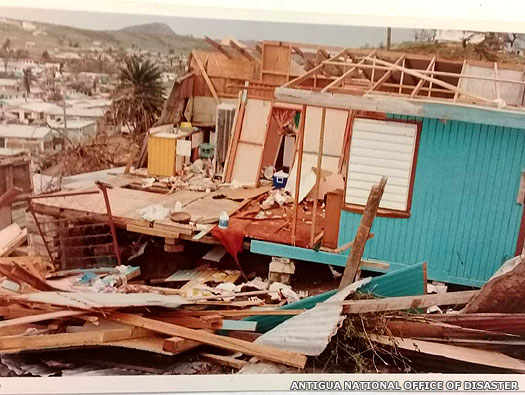 Destructive hurricanes were nothing new in the Caribbean, with Hurricane Luis leaving devastation in its wake across the Caribbean islands after it had passed on 5 September 1995, with three dead on Antigua and millions of dollars of damage done Destructive hurricanes were nothing new in the Caribbean, with Hurricane Luis leaving devastation in its wake across the Caribbean islands after it had passed on 5 September 1995, with three dead on Antigua and millions of dollars of damage done |
|
| 2004 |
Hurricane Ivan kills at least thirty-nine and causes about $815,000,000 in damages. Ninety percent of homes are damaged. The island's infrastructure is shattered, and tourism suffers. |
|
| 2008 - 2013 |
Sir Carlyle Glean |
Governor-general. |
| 2010 |
The International Monetary Fund provides $13.3 million in credit to help ameliorate the adverse effect of the global downturn on Grenada's economy. Grenada's banking reforms have helped to smooth the awarding of aid. |
|
| 2013 |
Lawrence Joseph |
Acting governor-general (for four days). |
| 2013 - On |
Dame Cécile La Grenade |
First female governor-general. |
| 2022 |
At least two painful exchanges take place between island governments in the Caribbean and the earl and countess of Wessex during their week-long tour of the British-linked Caribbean islands. Comments during a meeting on Antigua & Barbuda makes likely a future pursuit of full independence. 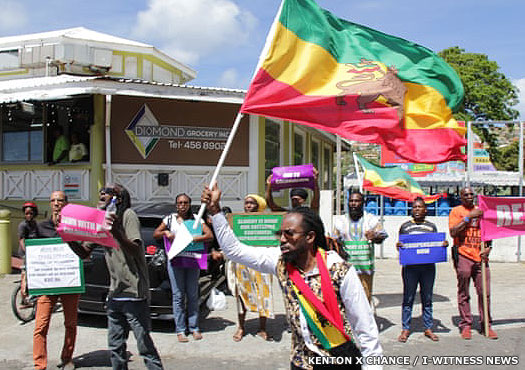 Protesters in St Vincent during the royal visit by the earl and countess of Wessex in 2022 showed that calls for independence were not going away Protesters in St Vincent during the royal visit by the earl and countess of Wessex in 2022 showed that calls for independence were not going away |
|
| St Kitts & Nevis also reveals its plan to cut ties with the United Kingdom, with a growing sense of injustice around the former slave trade being used as a key point. Earlier in the year the same sentiment has already been echoed by the Bahamas, Belize, Grenada, and Jamaica. |
|
|
 |
|
|
 Please note that the History Files does not regularly monitor changes in modern heads of state or their representatives. Get in touch here if this section requires updating.
Please note that the History Files does not regularly monitor changes in modern heads of state or their representatives. Get in touch here if this section requires updating.
 This 'Ring of Statues' in Grenada's Underwater Sculpture Park was created in 2006, following Hurricane Ivan, by British 'eco-artist' Jason de Caires Taylor, being located in the Molinere-Beauséjour Marine Reserve in Grenada
This 'Ring of Statues' in Grenada's Underwater Sculpture Park was created in 2006, following Hurricane Ivan, by British 'eco-artist' Jason de Caires Taylor, being located in the Molinere-Beauséjour Marine Reserve in Grenada Photographed together here, John F Kennedy and Nikita Kruschev had, in 1962, played the world's biggest game of brinkmanship as the USA and Soviet Union vied for supremacy, centred around Cuba
Photographed together here, John F Kennedy and Nikita Kruschev had, in 1962, played the world's biggest game of brinkmanship as the USA and Soviet Union vied for supremacy, centred around Cuba Two US soldiers hold three suspected members of the People's Revolutionary Army at gunpoint in St George's, Grenada, during the Grenada Invasion of 1984 to restore democracy to the island upon the orders of President Ronald Reagan
Two US soldiers hold three suspected members of the People's Revolutionary Army at gunpoint in St George's, Grenada, during the Grenada Invasion of 1984 to restore democracy to the island upon the orders of President Ronald Reagan Destructive hurricanes were nothing new in the Caribbean, with Hurricane Luis leaving devastation in its wake across the Caribbean islands after it had passed on 5 September 1995, with three dead on Antigua and millions of dollars of damage done
Destructive hurricanes were nothing new in the Caribbean, with Hurricane Luis leaving devastation in its wake across the Caribbean islands after it had passed on 5 September 1995, with three dead on Antigua and millions of dollars of damage done Protesters in St Vincent during the royal visit by the earl and countess of Wessex in 2022 showed that calls for independence were not going away
Protesters in St Vincent during the royal visit by the earl and countess of Wessex in 2022 showed that calls for independence were not going away